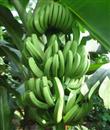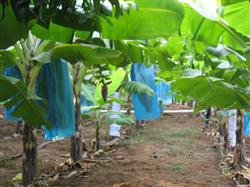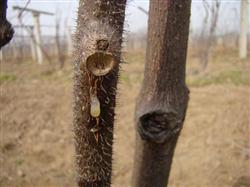Planting techniques of Banana in Brazil

First, the selection of banana orchards in Brazil requires loose soil, deep and fertile soil, low groundwater level, easy drainage and irrigation, adequate sunshine and air, and easy transportation. At present, most banana plants in our city use paddy fields, the groundwater level of paddy fields is generally high, drainage and irrigation is not timely enough, lowering the groundwater level and timely drainage and irrigation is the key, therefore, the method of land preparation with deep ditch and high border is applied. Clean up the stump of the previous stem, and then plough it and turn it to the sun. The best time for tanning is one and a half to two months. In order to facilitate air circulation, the direction of the border should be parallel to the normal wind direction, the width of the border should be 2.5-2.7m, the width of the ditch is 50-60cm, and the depth is about 50cm. The depth and width between each two borders can be relatively shallow and narrow, which can be used as fertilizer application points when young ears differentiate into joint borders. 2. Preparation and burrowing of base fertilizer in order to achieve high yield of Brazilian banana, we must prepare sufficient base fertilizer, which accounts for 20% of the amount of fertilizer needed during the whole growing period. The base fertilizer is mainly organic fertilizer, such as chicken manure, pig and cow manure, manure pit mud, etc., the base fertilizer should be compost with phosphate fertilizer and a small amount of lime, and the base fertilizer per mu should not be less than 2500kg. In general, holes should be dug 15 days before planting. The hole is dug in the middle of the border, and the distance between the holes is 2.0 meters, so that 120-130 plants can be planted per mu. The specification of hole drilling should be 60 × 60 × 60cm, and the depth should be determined according to the level of groundwater table. If it is low, it can be dug deeper, and vice versa. 3. Selection and planting of seedlings 1. Selection of seedlings Brazilian banana seedlings should select test-tube seedlings cultivated by legal management units. The designated breeding units of Brazilian banana in our city include Municipal Institute of Agricultural Science, Shuikou Agricultural Technology Station, Zhenlong Agricultural Technology Station, Dongzhen Agricultural Technology Station and Dingburg Agricultural Technology Station. The first-class seedlings of these units are provided by the Guangzhou Agricultural Science Base, the purity of the seedlings is guaranteed, they are strictly quarantined, they are free from disease, and the successive generations meet the standards. at the same time, the technical strength of these departments is strong, the seedlings raised are good, and the after-sales service comes home. 6-8 new leaves should be selected, the base of the pseudo-stem is stout, the stem height is 8-10 cm, and the leaves are green, free from variation and disease-free. The seedlings should be sprayed with 600x omethoate and 800x carbendazim 2-3 days before planting, and can also be applied 0.1-0.2% compound fertilizer solution (1 ∶ 1 ∶ 1). 2. Field planting of bananas in our city is mainly spring planting, and the best time is early March (before and after sting), when the cold winter has passed, the weather is getting warmer, Rain Water increases, the planting survival rate is high, and there are few diseases and insect pests. The first banana is harvested before and after the Spring Festival, and the second banana is harvested during the Mid-Autumn Festival, when the temperature is not high, it is easy to keep fresh and transported, and the price is ideal. Before planting, the base fertilizer should be 20-25kg under each hole, and the rotten poultry, pig and cow manure is the best. The base fertilizer mixed with the soil of the plough layer should be placed in the lower part of the hole and covered with 15cm soil. Because the test-tube plantlets are delicate, the root system is fine, and the penetration ability is poor, the planting soil should be broken, loose and not hardened. Shallow planting, gently remove the nutrition cup, do not destroy the structure of the nutrient soil in the cup, cover the nutrient mud not more than 1cm when returning to the soil, drench enough fixed root water, the survival rate of shallow species is high, and the early growth is fast, but with the growth to a certain extent, the corm will be exposed to the ground, so it is necessary to reserve some soil for soil preparation. Fourth, fertilizer and water management test-tube banana seedlings in the early stage is relatively weak, poor absorption, based on the principle of frequent application and light application. After planting, before the two true leaves are unfolded, it is generally not suitable to apply fertilizer, which is mainly drenched with water, which should be drenched before the sun comes out in the morning or after 4 to 05:00 in the afternoon, and cannot be drenched at the head. It should be watered around the base of banana seedlings. After the first or second new leaves are unfolded after planting, fertilization begins before 50 cm in height, with 1 ∶ 1 ∶ 1 compound fertilizer 2 taels, urea 1 2 boiled water 100kg, 1-2 jin per plant, and rotten dilute dung water can also be used. It is required to apply once a week, when the plant pseudostem is more than 50 cm, begin to spread, mainly compound fertilizer, combined with soil cultivation. According to the plant growth, foliar fertilizer was sprayed to make the growth neat and consistent. About 6 months after planting, the newly drawn leaves reached 25, and the pseudostem was about 150 cm high. The Brazilian banana began to enter the young panicle differentiation stage and differentiated to bud for about 30 days, which was the key time to determine the yield. The leaves must be kept thick green and disease-free, and the stems are healthy and sturdy. Entering the young panicle differentiation stage, the banana has a strong absorption of fertilizer and water, so it is necessary to re-apply fertilizer, accounting for about 30% of the whole growth period. During this period, hole application was used to apply fertilizer. 2-3 days before fertilization, a hole of 150cm × 40cm was opened in the middle of the two banana trees, and then 1 ∶ 1 ∶ 1 compound fertilizer 1.5kg was applied to the manure of rotten poultry, cattle and pigs, covering a soil layer of 10cm. About eight months after planting in the field, the Brazilian banana entered the budding period, which must be carefully managed, the bud condition must be checked frequently, and the axle at the top of the leaf tip should be strictly prevented from breaking the axis, resulting in long-term hard work and vanishing in an instant. During this period of about one month from budding to bud breaking, foliar fertilizer is mainly applied and properly sprayed according to the growth trend of banana trees, so as to reduce the difference of fruit weight of head and tail comb. it is better to comb one ear on 9-11, and pay attention to dredging "banana" and "three-layer banana". The amount of fertilizer from bud breaking to bud breaking accounts for about 10% of the total fertilizer amount in the whole growth period. Fertilizer and water management after bud breaking to before harvest is a key period to ensure good fruit shape. To maintain more green leaves, nutrients should be sufficient (fertilizer application accounts for about 20% of the whole growth period). Acupoint application should be carried out according to the growth condition. Brazilian banana has large stems and leaves and a lot of water transpiration. Most of the roots are distributed in the topsoil layer and need sufficient water, but they are also very sensitive to waterlogging. Therefore, scientific drainage and irrigation must be carried out. The irrigation methods of banana garden can be divided into three forms: flood irrigation, furrow irrigation and irrigation irrigation, among which irrigation is more suitable in our city. Irrigation is to introduce water into the border ditch and then use manual or mechanical water to wet the border surface or hole surface, so that the soil contains about 65% water, and then drain the water, do not store water in the banana garden for a long time, otherwise it will cause rotten roots. The time interval for irrigation depends on the moisture content of the soil. The simple way is to take the soil from the soil layer of more than 25 centimeters, and it is impossible to hold it into a ball by hand. When the hand feels dry, it is necessary to irrigate and solve the drought immediately, but it feels like water sticking to the hand, and the pressure of the mud mass is not easy to disperse, indicating that there is too much water content in the soil. It is necessary to clear the ditch to drain and lower the groundwater level.
- Prev

What is banana out-of-season cultivation?
Spring and summer bananas, also known as out-of-season bananas, refer to bananas harvested from mid-spring to early summer, mostly from March to May, and sometimes from February to June, including old bananas (snow plantains) and most new ones. Due to the lower temperature in winter and spring, the yield is lower. Our country is the off-season of fruit from March to May, so the price of banana is higher at this time, which is beneficial to the storage of banana.
- Next

Key points of control of kiwifruit canker in autumn
Kiwifruit canker is the most harmful disease to kiwifruit. As the weather turns cooler, the temperature drops, and the overcast and rain increases, it provides favorable conditions for the occurrence and infection of the disease. The prevention and control of kiwifruit canker should be done as soon as possible. The main technical points are as follows: strengthen cultivation management. It is necessary to apply more organic fertilizer and balanced fertilizer in autumn.
Related
- Moge, come on! The staff of the peasant association in the producing area of cantaloupe were frightened when the crowd gathered.
- Causes and Solutions of low Fruit setting rate of Apple
- Symptoms and control measures of passion fruit virus disease
- Fruit growing lesson: how do apple orchards keep high yields?
- Can you build orchards in the mountains? What are the pros and cons?
- How to manage the coloring period of Crisson grape?
- This paper introduces the processing technology of two kinds of fig products.
- How much is a month for retired teachers in rural areas by 2020?
- How can strawberry planting increase sugar content? We should pay attention to management in many aspects.
- What are the cultivation techniques on how to improve the yield of golden fruit?

